Settler Collector
(or, the Preserve for Critical Memory)Studio project, 2019
Monuments and memorials are narrative devices. They are symbols that offer a simple, unified, often congratulatory message about a group of people’s past, present, and future. Statuary has an extra layer of resonance because it is human shaped. We use human pronouns when we talk about statuary. They are often placed on plinths, above and out of reach of human bodies. Their gestures are exaggerated and symbolic. Their gaze is powerful and intentionally directed. Most of us understand this body language implicitly. They are hyper-legible symbols.
The same gestures and figures are employed across colonies and former colonies, offering similarly unified narratives. The pointing gesture, scroll, posture, and expression of City Hall’s George Vancouver is nearly identical to a statue of Christopher Columbus in Barcelona. There are at least a dozen statues of John A. MacDonald in Canada. Leaders like this are memorialized for their role in creating national institutions while their acts of violence are minimized. But what is the relationship between, for example, John A.’s white supremacy and the institutions that bear him as a mascot?


When monumental statuary is employed by institutions in this
way, it conveys messages about what and who the institution values. A similar filter
is applied to the subject’s life story and role in history. Monumental statuary
pares away contention, contradiction, and nuance in favour of a simple, often
celebratory, story. They reference this version of the past in order to project
a chosen future. This impoverished practice of memory marginalizes not only
other histories but also other presents and futures.
The statue of George Vancouver says something about the City of Vancouver’s conditions for citizenship. The statue of Matthew Baillie Begbie (known as ‘the hanging judge’) that used to stand outside the Law Courts in New West says something about who can expect the justice system to deliver justice. Not only the narrative offered by statuary but their connection to specific places deserves critical examination. Where do they belong? Are they equally harmful in other contexts? Is it possible for these objects to illuminate other histories instead of obscuring them? How does their meaning and effect change when they are relocated or reoriented? The statues’ connection to place performs the work of marginalization and forgetting even as it does the work of representation and memory.
In their current placements, these statues do not go uncontested. Statues and institutions are frequently the site of dialogic protest and performance. The John A. MacDonald statue in Montreal has been doused in paint at least three times this year alone. David Garneau’s performance piece ‘Dear John: Louis David Riel’has been performed in front of Macdonald statues in three Canadian cities. Halifax’s poet laureate Rebecca Thomas performed her poem ‘Not Perfect’ about that city’s Cornwallis statue at a city council meeting. The John A. statue at Queen’s Park in Toronto has been draped in red dresses for MMIWG2S. Artist Scott Benesiinaabandan created the counter-monumental installation work newlandia: debaabaminaagwad in response to a statue of Egertson Ryerson at Ryerson University. These acts of installation, performance, and protest are highly engaged with both history and futurity. They are memetic and counter-monumental, resulting in documentation, acts of solidarity, and sometimes sparking whole movements. Many acts of protest assert that these statues should be removed from these places of authority. Their traces online and in publications endure after these ephemeral acts are finished, recalling Jean Claude and Christo’s wrapped monuments.
In the current context of political turmoil around conservatism, reconciliation, and myriad related conflicts, these statues represent not only the past but the present and future. They are durable sites upon which many histories and futures are asserted; even the thrice-yearly vandalism of John A. in Montreal has not significantly harmed the statue’s material properties.
This project proposes that colonial statuary be removed from their emblematic locations outside of institutions. By assembling them in one place, this project aims to disrupt the monumentalization of singular, exclusionary stories. This project proposes a public space in which installation, performance, and protest are the primary intended program.
The act of removal and collection would likely change the responses elicited by the statues. What new dialogues would emerge once they are no longer institutional mascots? How would the presence of these statues change the context of superficially unrelated activities that happen on the site? How could the statues be leveraged in Tsleil-Waututh and Okanagan resistance to the transmountain pipeline, or a climate march or an anti-racism rally? In this new context, can these objects be appropriated to gain symbolic power?
This site was chosen because of its spatial relationship to City Hall. George Vancouver currently stands a storey above the site on the building’s central axis. There is no spatial or rhetorical distinction between the statue, the building, and the institution it houses. In contrast, the site is located several metres below the grade of City Hall, and behind it. While the park is still the property of City Hall, it is adjacent, not contiguous.
By locating the preserve for critical memory on this site, the institution of City Hall bears the burden of memory on behalf of its citizens. Pragmatically, this amounts to maintenance costs. Conceptually, this references the structural nature of colonialism and its origins in institutional culture. Institutions led the way in colonizing this continent and continue to shape people’s perceptions of the past and future; it seems right that institutions bear the material costs of critical memory work.
This site is already used for protest because of its proximity to government, though it is currently not ideal for this purpose. The proposed design increases openness and visibility, so protestors can see and appreciate the extent of their numbers. The overlook at the corner of Cambie and 10th avenue is highly visible and elevated, with a replica plinth that offers a space for installation pieces. The site offers multiple accessible entrances and exits, with a lane large enough for an ambulance.
The statue of George Vancouver says something about the City of Vancouver’s conditions for citizenship. The statue of Matthew Baillie Begbie (known as ‘the hanging judge’) that used to stand outside the Law Courts in New West says something about who can expect the justice system to deliver justice. Not only the narrative offered by statuary but their connection to specific places deserves critical examination. Where do they belong? Are they equally harmful in other contexts? Is it possible for these objects to illuminate other histories instead of obscuring them? How does their meaning and effect change when they are relocated or reoriented? The statues’ connection to place performs the work of marginalization and forgetting even as it does the work of representation and memory.
In their current placements, these statues do not go uncontested. Statues and institutions are frequently the site of dialogic protest and performance. The John A. MacDonald statue in Montreal has been doused in paint at least three times this year alone. David Garneau’s performance piece ‘Dear John: Louis David Riel’has been performed in front of Macdonald statues in three Canadian cities. Halifax’s poet laureate Rebecca Thomas performed her poem ‘Not Perfect’ about that city’s Cornwallis statue at a city council meeting. The John A. statue at Queen’s Park in Toronto has been draped in red dresses for MMIWG2S. Artist Scott Benesiinaabandan created the counter-monumental installation work newlandia: debaabaminaagwad in response to a statue of Egertson Ryerson at Ryerson University. These acts of installation, performance, and protest are highly engaged with both history and futurity. They are memetic and counter-monumental, resulting in documentation, acts of solidarity, and sometimes sparking whole movements. Many acts of protest assert that these statues should be removed from these places of authority. Their traces online and in publications endure after these ephemeral acts are finished, recalling Jean Claude and Christo’s wrapped monuments.
In the current context of political turmoil around conservatism, reconciliation, and myriad related conflicts, these statues represent not only the past but the present and future. They are durable sites upon which many histories and futures are asserted; even the thrice-yearly vandalism of John A. in Montreal has not significantly harmed the statue’s material properties.
This project proposes that colonial statuary be removed from their emblematic locations outside of institutions. By assembling them in one place, this project aims to disrupt the monumentalization of singular, exclusionary stories. This project proposes a public space in which installation, performance, and protest are the primary intended program.
The act of removal and collection would likely change the responses elicited by the statues. What new dialogues would emerge once they are no longer institutional mascots? How would the presence of these statues change the context of superficially unrelated activities that happen on the site? How could the statues be leveraged in Tsleil-Waututh and Okanagan resistance to the transmountain pipeline, or a climate march or an anti-racism rally? In this new context, can these objects be appropriated to gain symbolic power?
This site was chosen because of its spatial relationship to City Hall. George Vancouver currently stands a storey above the site on the building’s central axis. There is no spatial or rhetorical distinction between the statue, the building, and the institution it houses. In contrast, the site is located several metres below the grade of City Hall, and behind it. While the park is still the property of City Hall, it is adjacent, not contiguous.
By locating the preserve for critical memory on this site, the institution of City Hall bears the burden of memory on behalf of its citizens. Pragmatically, this amounts to maintenance costs. Conceptually, this references the structural nature of colonialism and its origins in institutional culture. Institutions led the way in colonizing this continent and continue to shape people’s perceptions of the past and future; it seems right that institutions bear the material costs of critical memory work.
This site is already used for protest because of its proximity to government, though it is currently not ideal for this purpose. The proposed design increases openness and visibility, so protestors can see and appreciate the extent of their numbers. The overlook at the corner of Cambie and 10th avenue is highly visible and elevated, with a replica plinth that offers a space for installation pieces. The site offers multiple accessible entrances and exits, with a lane large enough for an ambulance.

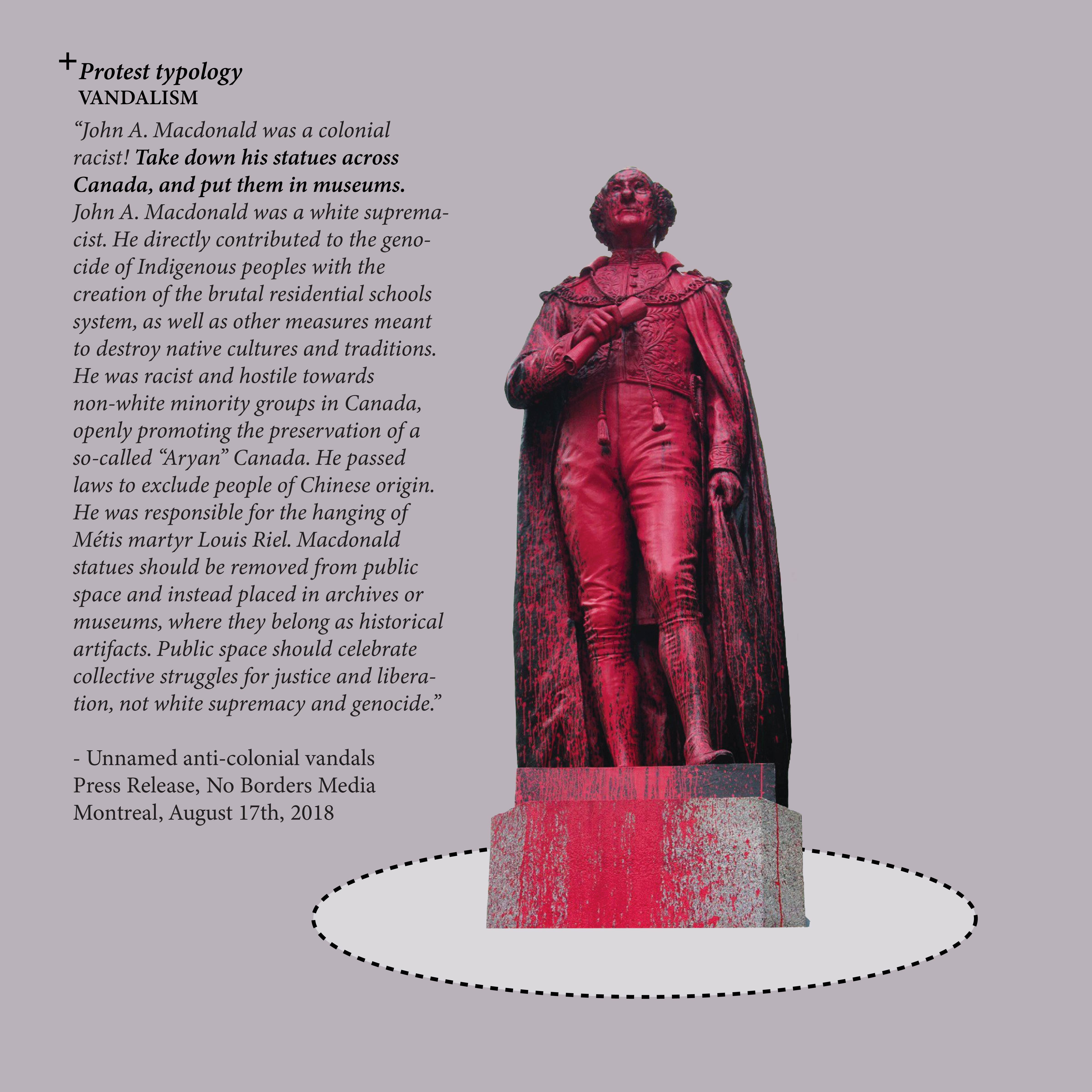
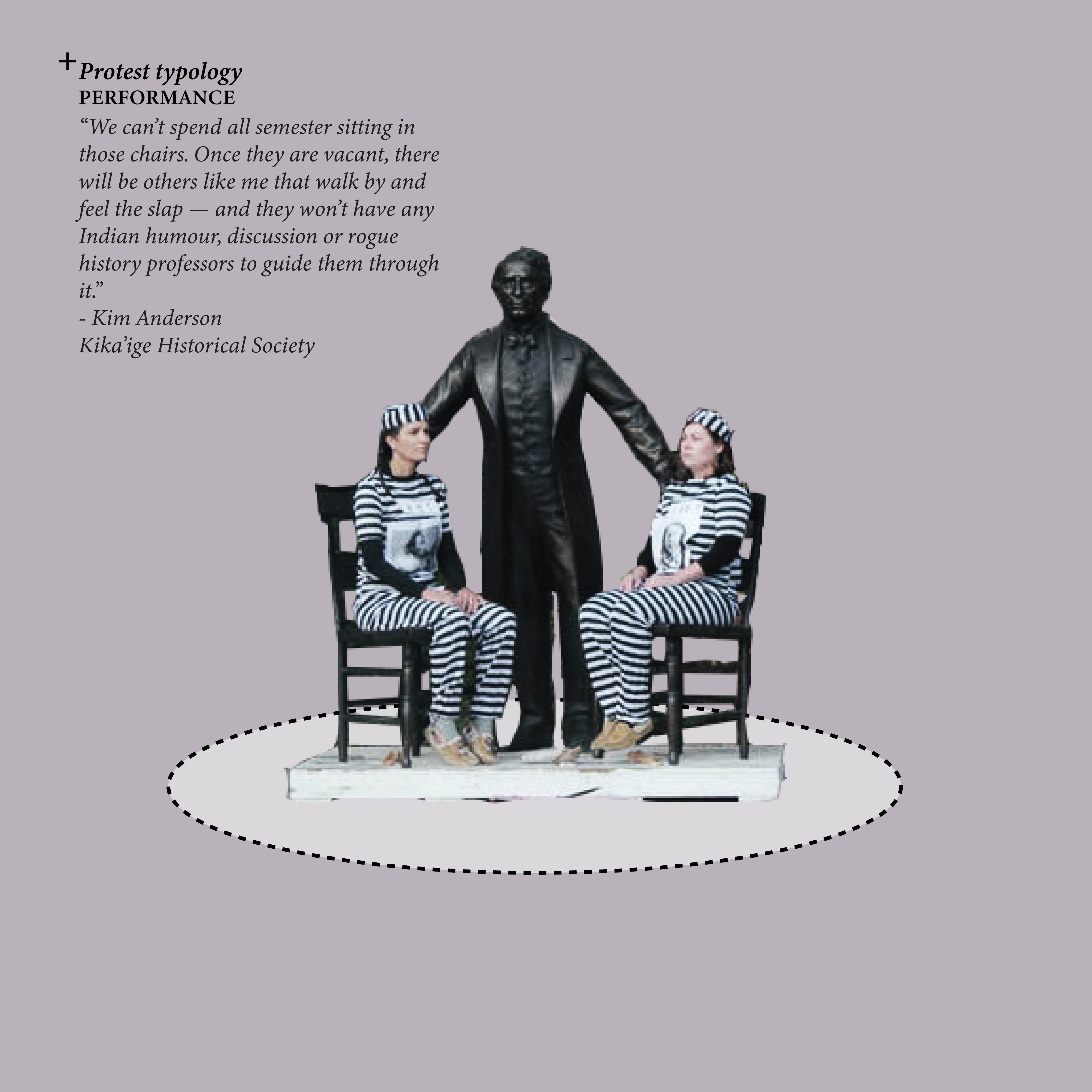
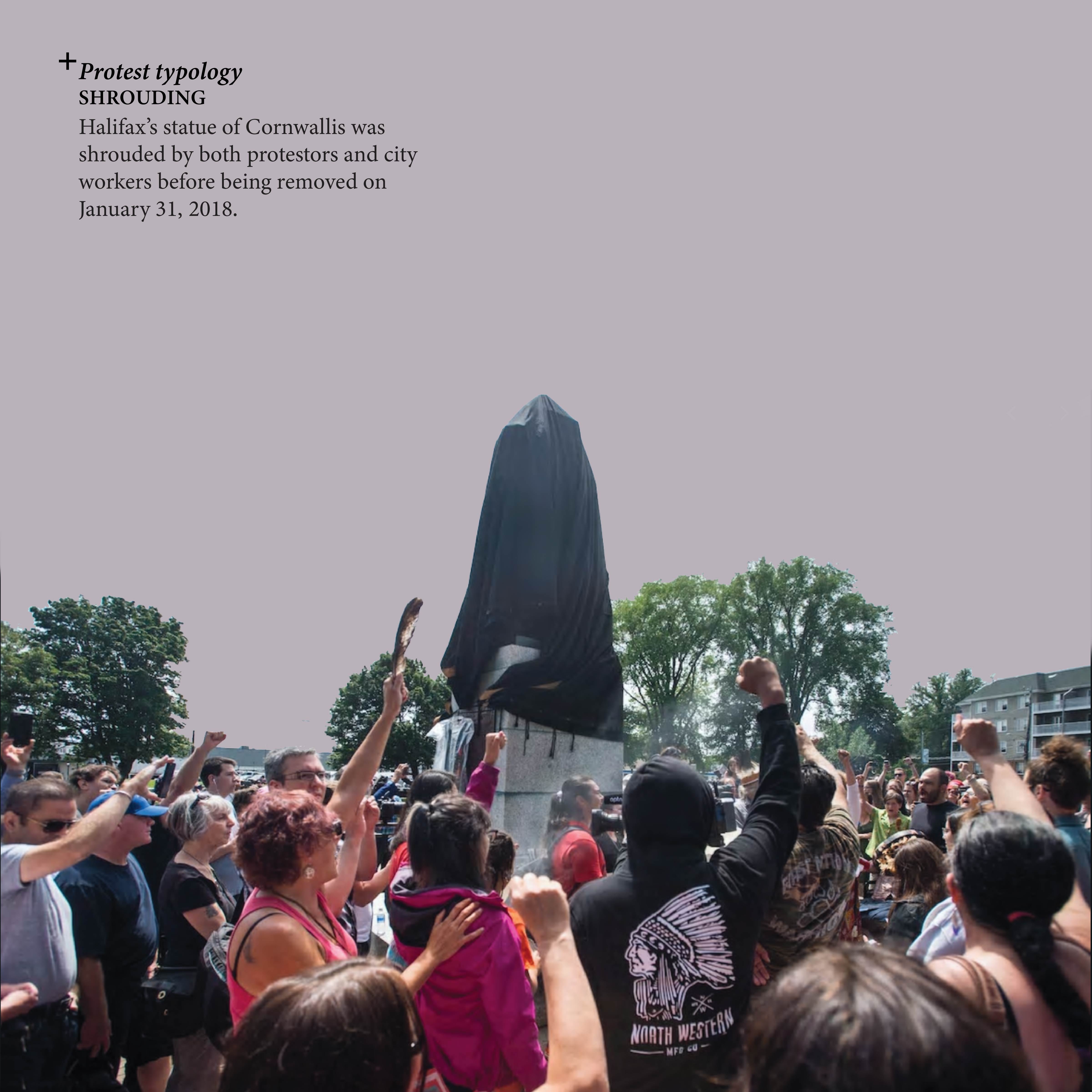

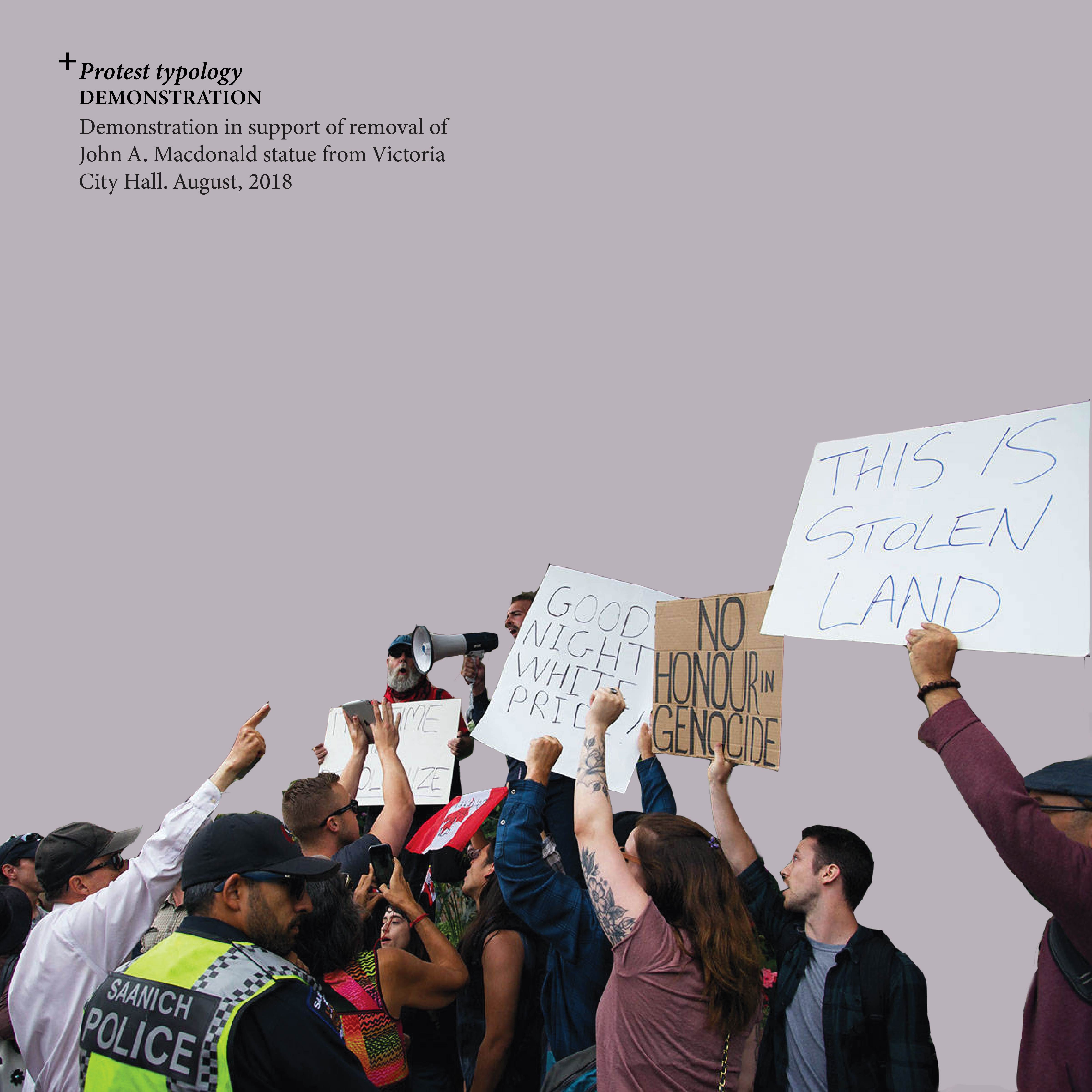




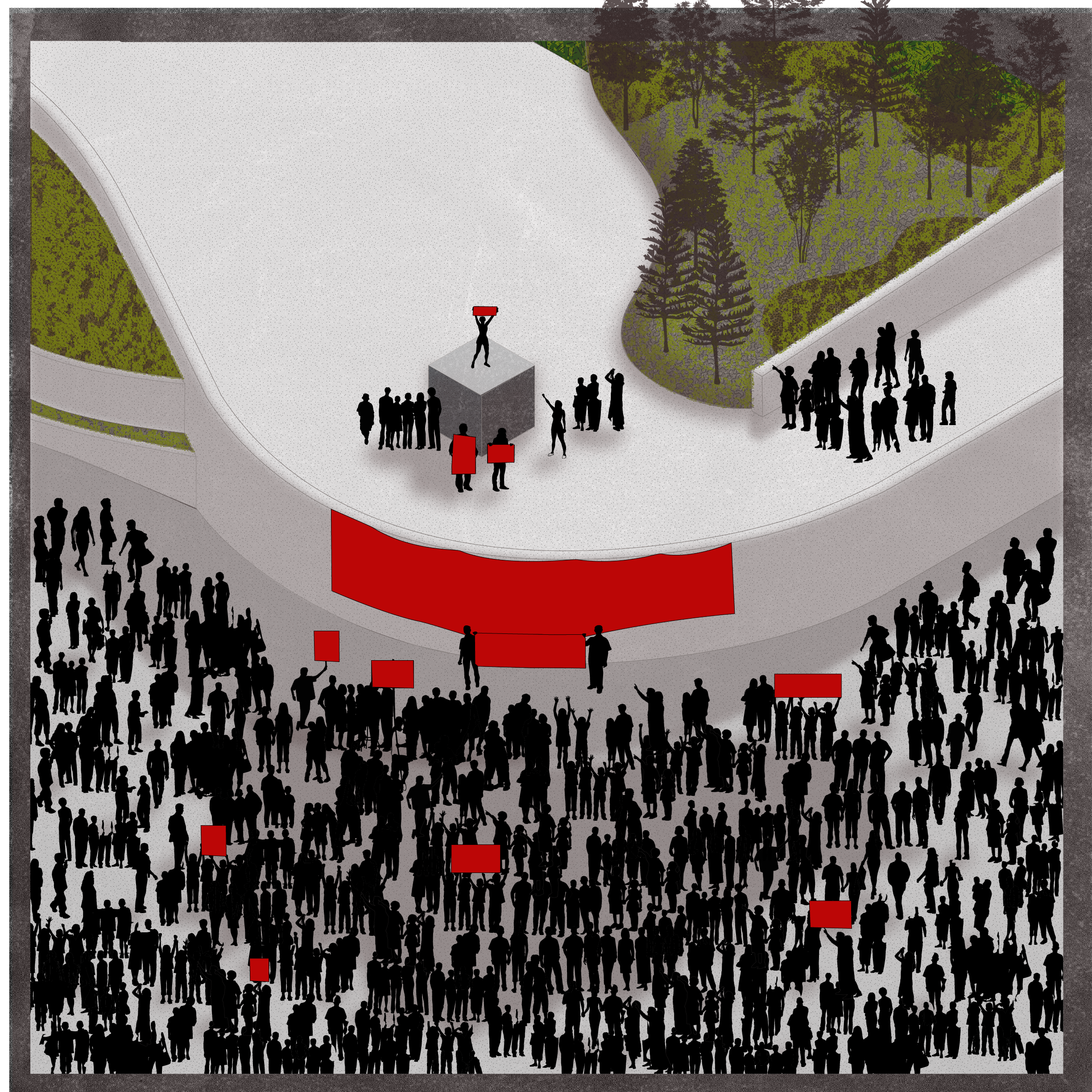
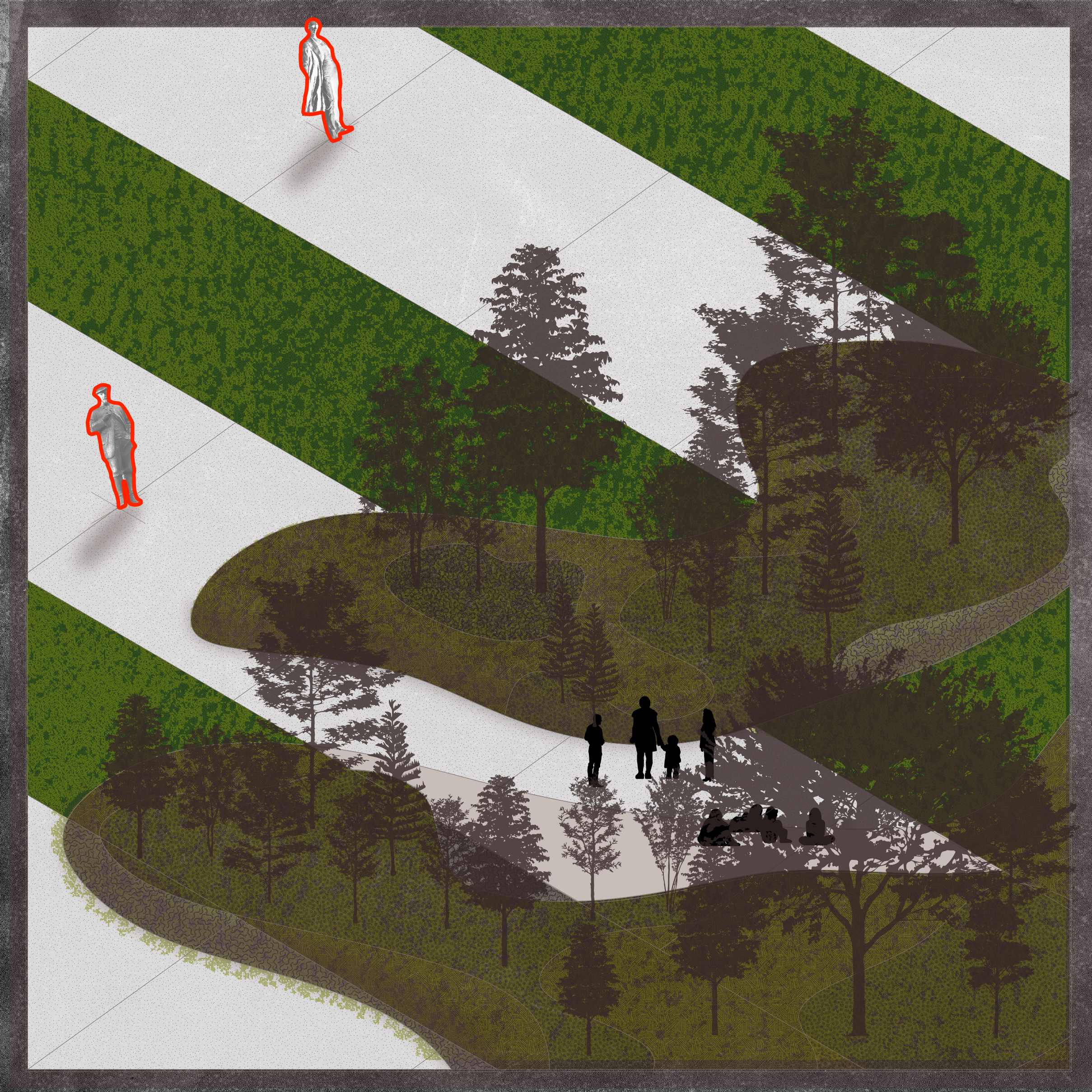

The
statues themselves are arranged on an offset grid, emphasizing their presence
as a collection of objects rather than as solitary authoritative symbols. This
also aligns them with the axis of the street grid. The design uses the existing
slope to unsettle any automatic reading of the statues; each is located on a
stripe of featureless andesite paving at a 12% grade, tilting each statue
sideways. The statues are removed from plinths and placed directly on the
ground, inviting direct bodily confrontation. Between them are stripes of flat
mowed lawn, referencing the existing condition of the site and the relationship
between statuary and the discipline imposed on the landscape by the colonial
project. This area is very exposed and very ordered, but the tilt of the
statues disrupts the regulated space of the lawns and paving. The statues all
face away from the blank andesite wall, referencing the black or white boxes of
galleries and theatres. Because their orientation carries such symbolic weight,
they are oriented in a way that subordinates them to these traditions of
expression and inquiry.
This arrangement is disrupted by a series of rain gardens and plantings on the western edge of the site. These curved forms of undisciplined plantings introduce a feeling of unresolve: are they advancing or retreating? Are these landscapes undergoing transformation? Are there two distinct spaces, or are there many?
This arrangement is disrupted by a series of rain gardens and plantings on the western edge of the site. These curved forms of undisciplined plantings introduce a feeling of unresolve: are they advancing or retreating? Are these landscapes undergoing transformation? Are there two distinct spaces, or are there many?
The notion of ‘unresolve’ has been important in my thinking about this project.
History is not finished yet; the production and use of these statues are part
of a shared story that is ongoing. Unresolve also acknowledges that the kind of
closure implied by the political project of reconciliation is not currently
possible. Unresolve implies inevitable change; that meaning is not fixed. This
project is not intended as a final solution, but as a liminal place where unresolve
and conflict are embodied and confronted. I hope that viewers can imagine a
future in which this space is no longer necessary, and the meaning of these
statues is utterly transformed.
![]()
